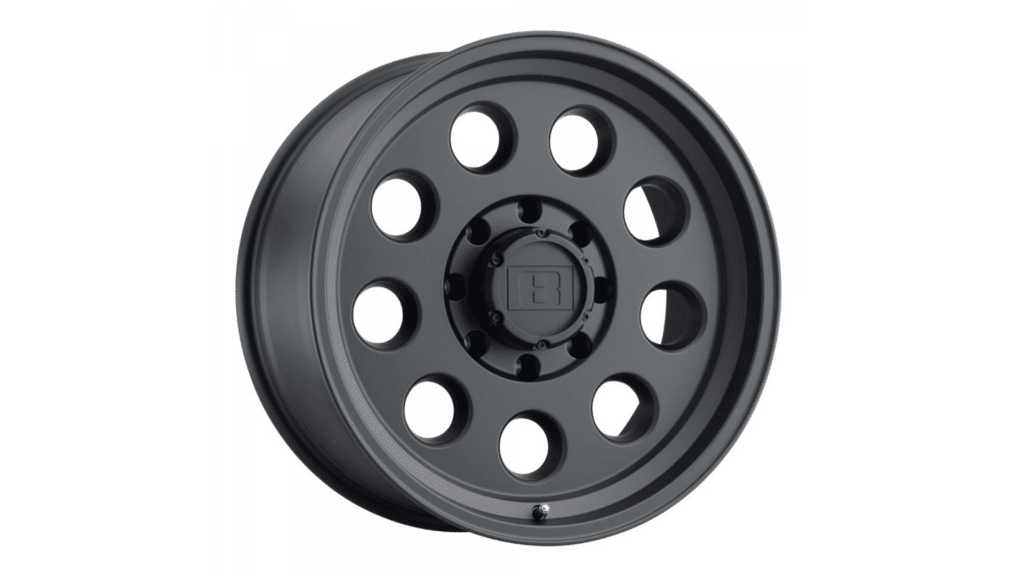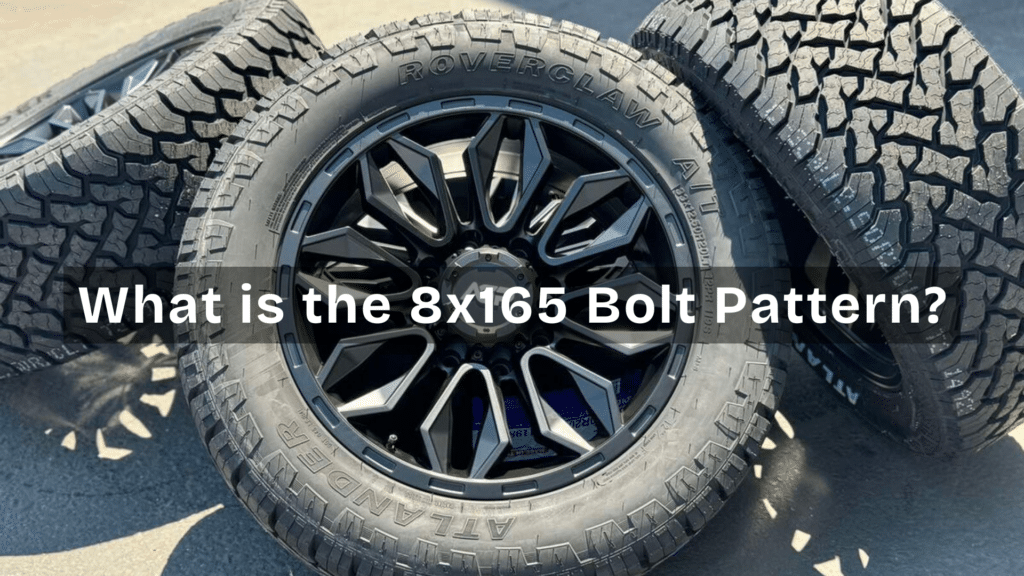If you’re looking for wheels with an 8×165 bolt pattern, knowing exactly what that means is important. This bolt pattern is common on heavy-duty trucks and older Chevy, GMC, and Dodge models.
If the wheels don’t match this pattern, they won’t fit properly, which can lead to safety issues.
In this blog, I’ll explain the 8×165 bolt pattern, which vehicles use it, and what you need to check before buying new wheels.
Whether you’re upgrading your truck’s look or replacing old rims, getting the right bolt pattern is important for a safe and smooth ride. Let’s get started!
What is the 8×165 Bolt Pattern and Why is it Important?

The 8×165 bolt pattern is a specific wheel setup used mostly on heavy-duty trucks. This means that the wheel has 8 lug nuts, and they are spaced 165 millimeters apart in a circular pattern.
Your wheels need to fit your truck perfectly for better safety and performance. If the bolt pattern doesn’t match, The wheels won’t bolt on properly and could wobble or come loose. It can also cause uneven wear or damage to your truck.
Always double-check the bolt pattern when buying new wheels to ensure they fit without modifications. Even if a wheel looks right, it won’t work unless the bolt pattern is an exact match.
Which Vehicles Have an 8×165 Bolt Pattern?
The 8×165 bolt pattern is mostly found on heavy-duty trucks from Chevrolet, GMC, and Dodge. These trucks need strong, secure wheels to handle heavy loads, towing, and tough road conditions.
If you’re looking for wheels with this pattern, here are the most common vehicles that use it.
- Chevy & GMC Trucks: Chevy 2500 (1988–2010), Chevy 3500 (1988–2010), GMC Sierra 2500 (1988–2010) and GMC Sierra 3500 (1988–2010).
- Dodge Trucks: Dodge Ram 2500 (1994–1999) and Dodge Ram 3500 (1994–1999).
These trucks rely on the 8×165 pattern for strength and stability. If you own one, make sure any new wheels match this exact pattern for a smooth ride.
How to Measure the 8×165 Bolt Pattern
If you’re unsure whether your truck has an 8×165 bolt pattern, you can measure it yourself in just a few minutes. It’s simple, and all you need is a measuring tape. Here’s how to do it the right way.
Step 1: Count the Lug Nuts: Look at your wheel and count how many lug nuts there are. If you have 8 lug nuts, you’re already halfway there!
Step 2: Measure the Bolt Circle
- Pick one lug nut and find the one directly across from it.
- Use a measuring tape to measure from the center of one lug to the center of the one across from it.
- If the distance is 165mm (about 6.5 inches), your bolt pattern is 8×165.
Now you know your truck’s bolt pattern. Use this when shopping for new wheels to make sure they fit perfectly.
Choosing the Right Wheels for an 8×165 Bolt Pattern
If your truck has an 8×165 bolt pattern, picking the right wheels isn’t just about looks—it’s also about fit, safety, and performance. Before you buy, here’s everything you need to know to get the perfect set.
1. Double-Check the Bolt Pattern
Make sure your wheels have the exact 8×165 bolt pattern (also called 8×6.5 inches). This means the wheel has 8 lug nuts, spaced 165mm apart in a circle.
If you try to use wheels with a different bolt pattern, they simply won’t fit. Even if they seem close, an incorrect pattern can lead to unsafe driving conditions, vibrations, and uneven tire wear.
2. Choose the Right Wheel Size
Not all wheels are the same size, and picking the right diameter and width is important for performance and handling.
If you’re upgrading to bigger wheels, check that your truck’s suspension and tires can handle the change. Larger wheels often need lower-profile tires to keep the overall tire height the same.
3. Check the Offset and Backspacing
These determine how the wheels sit on your truck. Offset refers to how far the wheel’s mounting surface is from the center of the wheel.
Backspacing is the distance from the wheel’s mounting surface to the back of the wheel. Too much backspacing can cause the wheels to rub against suspension parts, while too little can make them stick out too far.
4. Match the Hub Bore Size
The hub bore is the hole in the center of the wheel. It must match your truck’s hub size exactly for a smooth and secure fit. If the hub bore is too big, you might experience vibrations or poor handling.
If you find wheels with a larger hub bore, you can use hub-centric rings to fill the gap. However, if the hub bore is too small, the wheels won’t fit at all. Always check this measurement to avoid problems.
5. Choose the Right Lug Nuts
Different wheels may require different types of lug nuts to fit properly. Conical lug nuts are used on many aftermarket wheels. Flat lug nuts are found on some factory-style wheels and spline lug nuts are used for certain custom or security-focused wheels.
Using the wrong lug nuts can lead to loose wheels, stripped threads, or even wheel detachment while driving. Always use the correct type of lug nuts that match your wheels.
6. Consider Tire Size Compatibility
If you’re changing wheel size, you need to make sure the tires match properly. Bigger wheels often need low-profile tires, whereas smaller wheels might require thicker tires for the right fit and performance.
If your tire size isn’t correct, it can throw off your speedometer, handling, and even gas mileage. Check a tire size calculator or ask a tire expert before making any big changes.
A little research now will save you time, money, and frustration later. With the right set of wheels, your truck will be ready for the perfect upgrade.
Helpful Tips When Buying New Wheels
Buying new wheels is exciting, but getting the right fit is important. Here are some simple tips to avoid mistakes and keep your truck safe.
- Check the Bolt Pattern: If it doesn’t match your truck, the wheels won’t fit. For example, an 8×165 bolt pattern must match exactly.
- Pick the Right Size: Bigger wheels look great but may need low-profile tires. Smaller wheels give a smoother ride.
- Check Offset & Backspacing: The wrong offset can cause rubbing or handling issues. Stick to your truck’s recommended specs.
- Match the Hub Bore: The center hole must fit your truck’s hub. If it’s too big, you’ll need hub-centric rings.
- Use the Right Lug Nuts: Some wheels need special lug nuts. The wrong type can lead to loose wheels.
Double-check everything before buying for a perfect and safe fit!
Conclusion
Choosing the right wheels for your truck isn’t just about looks—it’s about safety, fit, and performance.
If the wheels don’t match your bolt pattern, size, or offset, they won’t fit properly, and that can cause problems like wobbling, poor handling, or uneven tire wear.
Before buying new wheels, always double-check your bolt pattern (for example, 8×165) and make sure the size works with your truck.
Pay attention to offset, hub bore size, and lug nuts to avoid any issues. If you’re upgrading to bigger wheels, make sure your tires are the right fit, too.
The right wheels will not only make your truck look great but also keep it safe and stable on the road.
Frequently Asked Questions
What does 8×165 mean?
This means that the wheel has 8 lug nuts, which are 165mm apart in a circular pattern. This bolt pattern is common on heavy-duty Chevy, GMC, and Dodge trucks.
Can I use an 8×170 wheel on an 8×165 truck?
No. Even though they both have 8 lug nuts, the spacing is different. If the bolt pattern doesn’t match exactly, the wheels won’t fit properly, which can cause handling issues and safety risks.
Can I put bigger wheels on my truck?
Yes, but you need to make sure they fit without rubbing. Bigger wheels usually require low-profile tires to keep the overall diameter the same.
Do I need hub-centric rings?
If the hub bore of your new wheels is larger than your truck’s hub, you may need hub-centric rings to prevent vibrations. If the bore is too small, the wheels won’t fit at all.
What kind of lug nuts do I need?
It depends on the wheels. Some require conical, flat, or spline lug nuts. Using the wrong type can cause loose wheels or damage the threads. Always use the correct lug nuts for your wheels.


